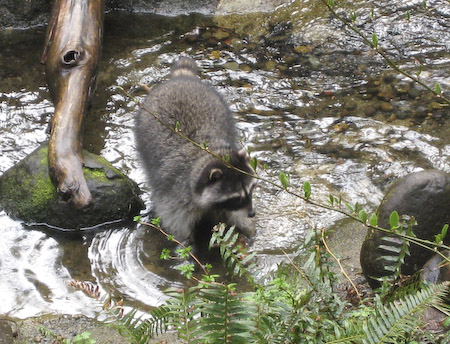|
The answer is RACCOON.
 Raccoons have a giant difference in the size of their
front/hind feet, and the small-large-small-large pattern is classic for
raccoon. Raccoons also sometimes travel in packs. The marsh is ideal
habitat for raccoon. In the case of these raccoons, the railroad is also
part of their habitat - they sometimes visit it to feed on carrion of
unfortunate train-killed animals. Even more unfortunately, the raccoons
themselves are sometimes killed by trains while feeding on the carrion.
The cold weather and the fact that the raccoons plunged
into the icy water were a couple surprises in there to fool everybody. I
don't come across raccoon tracks often in winter, and was not expecting
raccoon on such a frigid morning. The first tracks on this trail that I
spied were the tracks going into the water, and I was thinking otter. I
was confused, as the tracks seemed small for otter. Then I encountered
the 3 sets of tracks going across the ice, and I thought, "How odd
for 3 otters to travel across 40 feet of ice without a single belly
slide!" Then I studied the foot pattern and said aha. I realized I
had seen other occasions in winter where raccoons had entered &
exited cold, deep, swift-moving water multiple times, without any
apparent aversion to getting chilled.
What I have learned from this is that while raccoons
don't appear to be highly active during winter, they don't seem to be
fussy about choosing the warmest days to go active, like a skunk would
for instance.
Hope you enjoyed the quiz and stay tuned for the next
one.
Brian |